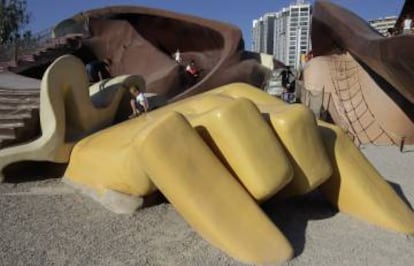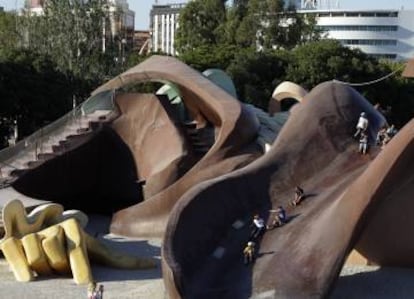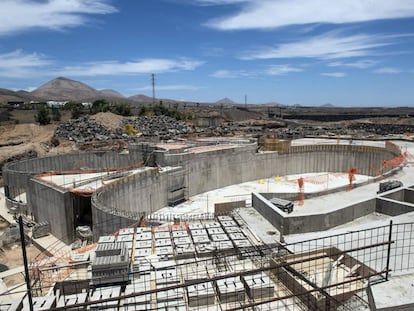Giant Gulliver stands the test of time
The unusual 67-meter-long figure in Valencia is celebrating its 25th anniversary

It’s afternoon in Valencia. It’s been hot as hell and now it’s drizzling. But rain or shine, the 67-meter-long and nine-meter-high statue of Gulliver that lies in the former Turia riverbed is crawling with children, some walking across his head and others whooshing down the gigantic slides that have been worked into the folds of his clothes – in much the same way as the tiny inhabitants of the country of Lilliput did in Jonathan Swift’s satirical novel, Gulliver’s Travels, after tying the “giant” Gulliver to the ground.
“We’ve been to a lot of places, but we’ve never seen anything like this,” says Miriam Grailhe, a French tourist whose children are aged two and 14. “It’s very original.”

Valencia’s Gulliver has just been chosen by the Design Museum Boston as one of the most extraordinary playgrounds on the planet. Not only that, it has been a guaranteed success with kids since it was created 25 years ago.
The sculpted play space was the brainchild of architect Rafael Rivera who worked with Manolo Martín, a specialist in folkloric “Fallas” art, and Sento Llobel, an artist from the so-called Valencian New School whose illustrations have been included in the first exhibition of comics from the Valencia Institute of Modern Art (IVAM).
“Our idea was to create a fun place that would bring different play elements together instead of having them scattered around,” says Rivera, who was commissioned by the city to create an innovative play area.
“When they handed the project over to me, they had already tried to do something more realistic,” recalls Llobel. “But to simply have a man laid out seemed a bit grim, as if someone had died. He needed a touch of fantasy – a more man-made look.”
Llobel bought all the illustrated copies of Gulliver’s Travels and films he could lay his hands on. “In the end, I was like, ‘This is no use to me. I’m going to have to actually invent something.’ And after researching the fashions of the era, that’s what I did.”
Childproof and durable, Llobel’s Gulliver has proved “a space that offers children a unique experience,” according to Elisabet Quintana, landscape architect and member of the dePaisea editorial team – a publication that assesses children’s play zones. “The approach to this kind of thing is generally standardized with the odd exception. The same thing is put up in natural parks and squares and by the beach,” she says.

Quintana draws attention to the educational element of Gulliver that encompasses not only the allusion to Swift’s novel, which was written in 1726, but also the inspiration taken from the Fallas monuments – the huge papier mâché effigies that are set alight each year in Valencia at the end of the city’s fiestas.
Of course, such a venture proved more costly than a standard children’s park, and local authorities balked at spending the required €1.2 million at the end of the 1980s after the City of Arts and Sciences further down the Turia riverbed had put them €1 billion over budget. In the event, the statue’s construction didn’t get underway until the Valencian authorities came up with the cash in response to bids from Seville (for the 1992 Expo) and Barcelona (for the Olympics) for the figure.
But while it cost more than the average children’s park to erect, access is free, which is one of the keys to its success. It means that children from all walks of life come together to play on it. “It has the value of any public area,” says Rivera. “It is one of those places where the city breathes and weaves people together.”
English version by Heather Galloway.
Sign up for our newsletter
EL PAÍS English Edition has launched a weekly newsletter. Sign up today to receive a selection of our best stories in your inbox every Saturday morning. For full details about how to subscribe, click here
Tu suscripción se está usando en otro dispositivo
¿Quieres añadir otro usuario a tu suscripción?
Si continúas leyendo en este dispositivo, no se podrá leer en el otro.
FlechaTu suscripción se está usando en otro dispositivo y solo puedes acceder a EL PAÍS desde un dispositivo a la vez.
Si quieres compartir tu cuenta, cambia tu suscripción a la modalidad Premium, así podrás añadir otro usuario. Cada uno accederá con su propia cuenta de email, lo que os permitirá personalizar vuestra experiencia en EL PAÍS.
¿Tienes una suscripción de empresa? Accede aquí para contratar más cuentas.
En el caso de no saber quién está usando tu cuenta, te recomendamos cambiar tu contraseña aquí.
Si decides continuar compartiendo tu cuenta, este mensaje se mostrará en tu dispositivo y en el de la otra persona que está usando tu cuenta de forma indefinida, afectando a tu experiencia de lectura. Puedes consultar aquí los términos y condiciones de la suscripción digital.
More information

Valencia’s IVAM museum overpaid for artworks by as much as 1,500%
Últimas noticias
The complicated life of Francesca Albanese: A rising figure in Italy but barred from every bank by Trump’s sanctions
How Japan is trying to avert ‘digital defeat’
Half of Scotland is in the hands of 420 property owners
Reinhard Genzel, Nobel laureate in physics: ‘One-minute videos will never give you the truth’
Most viewed
- Pablo Escobar’s hippos: A serious environmental problem, 40 years on
- Why we lost the habit of sleeping in two segments and how that changed our sense of time
- Charles Dubouloz, mountaineering star, retires at 36 with a farewell tour inspired by Walter Bonatti
- Reinhard Genzel, Nobel laureate in physics: ‘One-minute videos will never give you the truth’
- The Florida Keys tourist paradise is besieged by immigration agents: ‘We’ve never seen anything like this’










































